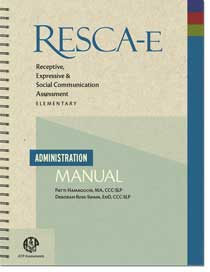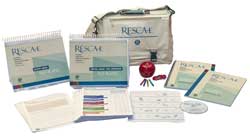

Author(s): Patricia Hamaguchi, MA, CCC-SLP / Deborah Ross-Swain, EdD, CCC-SLP
Description
Based on current research and designed for today's child, the RESCA-E was developed to provide essential information to professionals and parents about a child's receptive, expressive, and social communication language skills. It targets critical areas of language development which are often included in IEPs and treatment plans but are difficult or impossible to objectively measure with existing tests for the elementary-age population.
The RESCA-E combines standardized tests with informal observation across different settings to give a more complete picture of a child's communication skills.
The RESCA-E has 14 components, organized into three cores. Subtests can be selectively utilized to target specific skill areas. The three cores, their component subtests, and associated supplemental subtests are:
RECEPTIVE Core
Three subtests target receptive language at the word, sentence, and narrative levels:
Receptive Supplemental Subtests
Two supplemental subtests provide more detailed information:
SOCIAL COMMUNICATION Core
Three subtests make up the Social Communication Core. These are supplemented by one optional subtest (Elicited Body Language) and an observational scale to provide information about both a child's "testable" social-language knowledge and also his or her observed social behavior in the real world:
The ELCI is a rating scale that elicits information about a child’s observed receptive and expressive language and social/play skills.
The CASD provides a quick way to screen for children with ASD, regardless of age, IQ, or autism severity.
The ABAS-3 is a rating scale useful for assessing skills of daily living in individuals with developmental delays, autism spectrum disorder, intellectual disability, learning disabilities, neuropsychological disorders, and sensory or physical impairments.
The OPUS is a measure of listening (auditory) comprehension that evaluates a person's ability to listen to passages that are read aloud and recall information about them.
The Glaspey Dynamic Assessment of Phonology is the first standardized, dynamic assessment of speech production and stimulability.
The TOSR assesses breadth (the number of lexical entries one has) and depth (the extent of semantic representation for each known word) of vocabulary knowledge without taxing expressive language skills, providing an important new resource for individuals assessing children with possible language and literacy deficits.